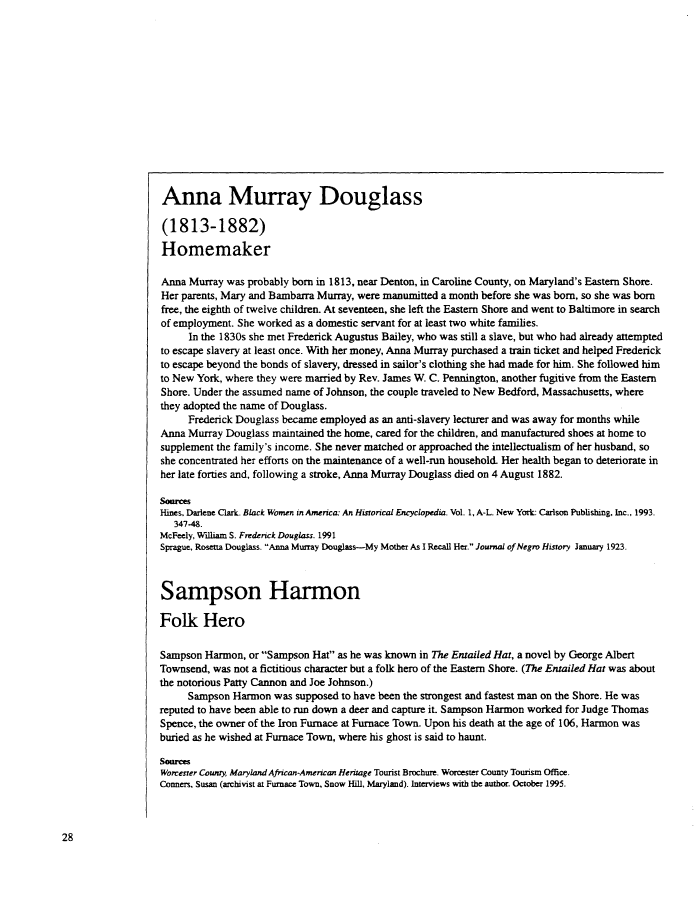 |
||||
|
TASK FORCE TO STUDY THE HISTORY AND LEGACY OF SLAVERY IN MARYLAND (Final Report) 1999/12/31 MdHR 991422 MdHR 991422, Image No: 388 Print image (63K) |
 |
||||
|
TASK FORCE TO STUDY THE HISTORY AND LEGACY OF SLAVERY IN MARYLAND (Final Report) 1999/12/31 MdHR 991422 MdHR 991422, Image No: 388 Print image (63K) |
| Anna Murray Douglass (1813-1882) Homemaker Anna Murray was probably born in 1813, near Denton, in Caroline County, on Maryland's Eastern Shore. Her parents, Mary and Bambarra Murray, were manumitted a month before she was born, so she was born free, the eighth of twelve children. At seventeen, she left the Eastern Shore and went to Baltimore in search of employment. She worked as a domestic servant for at least two white families. In the 1830s she met Frederick Augustus Bailey, who was still a slave, but who had already attempted to escape slavery at least once. With her money, Anna Murray purchased a train ticket and helped Frederick to escape beyond the bonds of slavery, dressed in sailor's clothing she had made for him. She followed him to New York, where they were married by Rev. James W. C. Pennington, another fugitive from the Eastern Shore. Under the assumed name of Johnson, the couple traveled to New Bedford, Massachusetts, where they adopted the name of Douglass. Frederick Douglass became employed as an anti-slavery lecturer and was away for months while Anna Murray Dougiass maintained the home, cared for the children, and manufactured shoes at home to supplement the family's income. She never matched or approached the intellectualism of her husband, so she concentrated her efforts on the maintenance of a well-run household Her health began to deteriorate in her late forties and, following a stroke, Anna Murray Douglass died on 4 August 1882. Sources Hincs, Darlene Clark. Black Women in America: An Historical Encyclopedia. Vol. 1, A-L. New York.: Carlson Publishing, Inc., 1993. 347-48. McFeely, William S. Frederick Douglass. 1991 Sprague, Rosetta Douglass. "Anna Murray Douglass—My Mother As I Recall Her." Journal of Negro History January 1923. Sampson Harmon Folk Hero Sampson Harmon, or "Sampson Hat" as he was known in The Entailed Hat, a novel by George Albert Townsend, was not a fictitious character but a folk hero of the Eastern Shore. (The Entailed Hat was about the notorious Patty Cannon and Joe Johnson.) Sampson Harmon was supposed to have been the strongest and fastest man on the Shore. He was reputed to have been able to run down a deer and capture it. Sampson Harmon worked for Judge Thomas Spence, the owner of the Iron Furnace at Furnace Town. Upon his death at the age of 106, Harmon was buried as he wished at Furnace Town, where his ghost is said to haunt. Sources Worcester County, Maryland African-American Heritage Tourist Brochure. Worcester County Tourism Office. Corners, Susan (archivist at Furnace Town, Snow Hill, Maryland). Interviews with the author. October 1995. 28 |